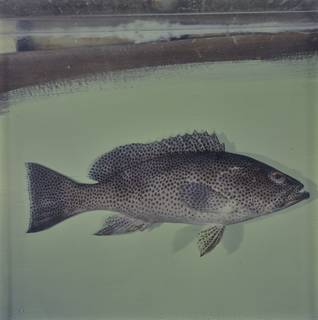WoRMS taxon details
Epinephelus chlorostigma (Valenciennes, 1828)
218199 (urn:lsid:marinespecies.org:taxname:218199)
accepted
Species
Epinephilus chlorostigma (Valenciennes, 1828) · unaccepted > misspelling - incorrect subsequent spelling
Serranus chlorostigma Valenciennes, 1828 · unaccepted
marine, brackish, fresh, terrestrial
Not documented
Description Found over a wide range of habitats like seagrass beds and outer reef slopes (Ref. 5213); in the South China Sea, it is...
Description Found over a wide range of habitats like seagrass beds and outer reef slopes (Ref. 5213); in the South China Sea, it is also found on mud bottoms. Feeds on small fishes and crustaceans (mainly stomatopods and crabs). Sexual transition from female to male occurs between 35-45 cm, but not all females change sex. @E. chlorostigma@ is closely related and very similar to @E. polylepis@ and @E. gabriellae@ which seem to replace it in the northwestern Indian Ocean. [details]
Froese, R. and D. Pauly. Editors. (2024). FishBase. Epinephelus chlorostigma (Valenciennes, 1828). Accessed through: World Register of Marine Species at: https://www.marinespecies.org/aphia.php?p=taxdetails&id=218199 on 2024-04-24
Date
action
by
![]() The webpage text is licensed under a Creative Commons Attribution-Noncommercial 4.0 License
The webpage text is licensed under a Creative Commons Attribution-Noncommercial 4.0 License
original description
(of Serranus celebicus multipunctatus Kossmann & Räuber, 1877) Bleeker, P. (1851). Nieuwe bijdrage tot de kennis der ichthyologische fauna van Celebes. <em>Natuurkundig Tijdschrift voor Nederlandsch Indië.</em> v. 2 (no. 2): 209-224. [details]
context source (HKRMS) Hong Kong marine fish database. <em>AFCD.</em> , available online at https://www.hk-fish.net/en/fish/introduction/ [details]
basis of record Randall, J. E. (1992). Red Sea Reef Fishes. <em>Immel Publishing.</em> [details]
additional source Liu, J.Y. [Ruiyu] (ed.). (2008). Checklist of marine biota of China seas. <em>China Science Press.</em> 1267 pp. (look up in IMIS) [details] Available for editors [request]
[request]
additional source Froese, R. & D. Pauly (Editors). (2023). FishBase. World Wide Web electronic publication. version (02/2023)., available online at https://www.fishbase.org [details]
ecology source Looby, A.; Erbe, C.; Bravo, S.; Cox, K.; Davies, H. L.; Di Iorio, L.; Jézéquel, Y.; Juanes, F.; Martin, C. W.; Mooney, T. A.; Radford, C.; Reynolds, L. K.; Rice, A. N.; Riera, A.; Rountree, R.; Spriel, B.; Stanley, J.; Vela, S.; Parsons, M. J. G. (2023). Global inventory of species categorized by known underwater sonifery. <em>Scientific Data.</em> 10(1). (look up in IMIS), available online at https://doi.org/10.1038/s41597-023-02745-4 [details]
context source (HKRMS) Hong Kong marine fish database. <em>AFCD.</em> , available online at https://www.hk-fish.net/en/fish/introduction/ [details]
basis of record Randall, J. E. (1992). Red Sea Reef Fishes. <em>Immel Publishing.</em> [details]
additional source Liu, J.Y. [Ruiyu] (ed.). (2008). Checklist of marine biota of China seas. <em>China Science Press.</em> 1267 pp. (look up in IMIS) [details] Available for editors
additional source Froese, R. & D. Pauly (Editors). (2023). FishBase. World Wide Web electronic publication. version (02/2023)., available online at https://www.fishbase.org [details]
ecology source Looby, A.; Erbe, C.; Bravo, S.; Cox, K.; Davies, H. L.; Di Iorio, L.; Jézéquel, Y.; Juanes, F.; Martin, C. W.; Mooney, T. A.; Radford, C.; Reynolds, L. K.; Rice, A. N.; Riera, A.; Rountree, R.; Spriel, B.; Stanley, J.; Vela, S.; Parsons, M. J. G. (2023). Global inventory of species categorized by known underwater sonifery. <em>Scientific Data.</em> 10(1). (look up in IMIS), available online at https://doi.org/10.1038/s41597-023-02745-4 [details]
 Present
Present  Present in aphia/obis/gbif/idigbio
Present in aphia/obis/gbif/idigbio  Inaccurate
Inaccurate  Introduced: alien
Introduced: alien  Containing type locality
Containing type locality
From other sources
Description Found over a wide range of habitats like seagrass beds and outer reef slopes (Ref. 5213); in the South China Sea, it is also found on mud bottoms. Feeds on small fishes and crustaceans (mainly stomatopods and crabs). Sexual transition from female to male occurs between 35-45 cm, but not all females change sex. @E. chlorostigma@ is closely related and very similar to @E. polylepis@ and @E. gabriellae@ which seem to replace it in the northwestern Indian Ocean. [details]Remark Frequently confused with E. Areolatus, Randall<307>. [details]
To Barcode of Life (34 barcodes)
To Biodiversity Heritage Library (15 publications) (from synonym Serranus chlorostigma Valenciennes, 1828)
To Biodiversity Heritage Library (19 publications)
To Biological Information System for Marine Life (BISMaL)
To Biological Information System for Marine Life (BISMaL) (from synonym Serranus chlorostigma Valenciennes, 1828)
To European Nucleotide Archive (ENA)
To FishBase
To FishBase (from synonym Serranus chlorostigma Valenciennes, 1828)
To FishBase (from synonym Serranus celebicus multipunctatus Kossmann & Räuber, 1877)
To FishBase images (Epinephelus chlorostigma, Saudi Arabia, by Field, R.)
To GenBank (73 nucleotides; 86 proteins) (from synonym Serranus chlorostigma Valenciennes, 1828)
To GenBank (73 nucleotides; 86 proteins)
To IUCN Red List (Least Concern)
To NMNH Extant Collection (Epinephelus chlorostigma FIN033765 Slide 120 mm)
To NMNH Extant Collection (Epinephelus chlorostigma FIN033767 Slide 120 mm)
To ITIS
To Biodiversity Heritage Library (15 publications) (from synonym Serranus chlorostigma Valenciennes, 1828)
To Biodiversity Heritage Library (19 publications)
To Biological Information System for Marine Life (BISMaL)
To Biological Information System for Marine Life (BISMaL) (from synonym Serranus chlorostigma Valenciennes, 1828)
To European Nucleotide Archive (ENA)
To FishBase
To FishBase (from synonym Serranus chlorostigma Valenciennes, 1828)
To FishBase (from synonym Serranus celebicus multipunctatus Kossmann & Räuber, 1877)
To FishBase images (Epinephelus chlorostigma, Saudi Arabia, by Field, R.)
To GenBank (73 nucleotides; 86 proteins) (from synonym Serranus chlorostigma Valenciennes, 1828)
To GenBank (73 nucleotides; 86 proteins)
To IUCN Red List (Least Concern)
To NMNH Extant Collection (Epinephelus chlorostigma FIN033765 Slide 120 mm)
To NMNH Extant Collection (Epinephelus chlorostigma FIN033767 Slide 120 mm)
To ITIS


